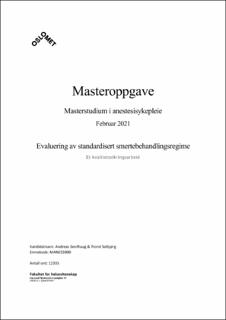Evaluering av standardisert smertebehandlingsregime med peroperativ infusjon av esketamin og lidokain - Et kvalitetssikringsarbeid
Abstract
Bakgrunn: Høsten 2018 ble det ved et norsk universitetssykehus implementert et standardisert smertebehandlingsregime for pasienter som gjennomgår laparaskopisk kolorektalkirurgi, som et ledd i en Enhanced recovery after surgery (ERAS)-retningslinje for denne pasientgruppen. Tanken med det standardiserte smertebehandlingsregimet var multimodal smertelindring og reduksjon av opioidkonsumet for denne pasientgruppen. Smertebehandlingsregimet har ikke blitt evaluert etter implementering. Målet for dette kvalitetssikringsarbeidet var å evaluere effekten av det standardiserte smertebehandlingsregimet med hensyn til faktorene postoperativ smerte og opioidkonsum. Med bakgrunn i dette har vi utarbeidet følgende problemstilling: «Fører standardisert smertebehandlingsregime med peroperativ infusjon av esketamin og lidokain til mindre smerter og lavere forbruk av opioider hos pasienter som gjennomgår laparoskopisk høyresidig hemikolekomi?» Metode: Kvalitetssikringsarbeidet ble gjennomført ved bruk av en historisk sammenligningsgruppe, heretter kalt historisk gruppe, hvor data ble høstet retrospektivt fra før det standardiserte smertebehandlingsregimet ble implementert. Disse dataene ble sammenliknet med en standardisert gruppe, hvor data ble høstet etter implementering av det standardiserte smertebehandlingsregimet. Data ble hentet fra elektronisk pasientjournal (EPJ) og inkluderte 29 pasienter. 19 pasienter fra historisk gruppe, og 10 pasienter fra den standardiserte gruppen. Pasientgruppene ble sammenlignet med utfallsmålene perioperativt opioidkonsum og postoperative smerter. Resultat: Den historiske gruppen hadde sammenlignet med den standardiserte gruppen 179,4% høyere smertescore ved ankomst postoperativ avdeling. I andre til fjerde postoperative time hadde den standardiserte gruppen 240% høyere smertescore enn den historiske gruppen. Den historiske gruppen mottok sammenlignet med den standardiserte gruppen 99,2% mer opioider i den perioperative perioden. Konklusjon: Funnene viser at pasientene i den standardiserte gruppen sammenlignet med den historiske gruppen har mer smerter postoperativt. Den standardiserte gruppen mottar totalt sett mindre opioider enn den historiske gruppen. Postoperativt mottar den standardiserte gruppen mer opioider enn den historiske gruppen. Imidlertid er utvalget lite, og det er flere faktorer som kan ha påvirket resultat. Ytterligere undersøkelser er nødvendig for finne ut om best mulig praksis blir fulgt. Background: In the autumn of 2018, a standardized pain treatment regimen was implemented at a Norwegian university hospital for patients undergoing laparoscopic colorectal surgery, as part of an Enhanced recovery after surgery (ERAS) guideline for this patient group. The idea of the standardized pain relief regimen was multimodal pain relief and reduction of opioid consumption for this patient group. The implemented procedure has not been evaluated after introduction. The aim of this quality assurance work was to evaluate the effect of a standardized pain relief regimen with regard to the factors postoperative pain and opioid consumption. Based on this, we have prepared the following problem: "Does standardized pain relief regimens with peroperative infusion of esketamine and lidocaine lead to less pain and lower opioid consumption in patients undergoing laparoscopic right-sided hemocolectomy? Method: The quality assurance work was carried out using a historical comparison group, where data were harvested retrospectively from before the standardized pain treatment regime was implemented. These data were compared with a standardized group, where data were harvested after implementation of the standardized pain management regimen. Data were obtained from electronic patient records and included 29 patients. 19 patients from the historical group, and 10 patients from the standardized group. The patient groups were compared with the outcome measures perioperative opioid consumption and postoperative pain. Results: The historical group had compared with the standardized group 179.4% higher pain score on arrival postoperative ward. In the second to fourth postoperative hour, the standardized group had a 240% higher pain score than the historical group. Compared to the standardized group, the historical group received 99.2% more opioids in the perioperative period. Conclusion: The findings show that patients in the standardized group compared to the historical pain have more pain postoperatively. The standardized group receives less opioids than the historical group. Postoperatively, the standardized group receives more opioids than the historical group. However, the sample is small, and there are several factors that may have influenced the result. Further research is needed to determine if best practices are being followed.
